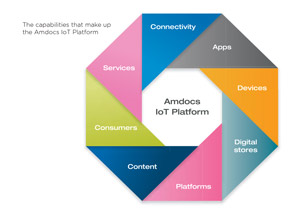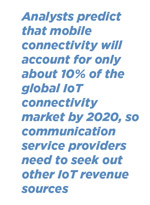As OEMs and service providers look to increase consumer IoT adoption, a seamless customer experience is vital, with simple exploration, registration and activation as the aims. Yuval Mayron, the general manager of the Amdocs Internet of Things business unit, tells Antony Savvas about how service providers and OEMs need to work together to deliver the next great technological revolution
Imagine a world where you can stay constantly updated about the location of your suitcase, the health of your car, and get alerts if the oil pressure in your motorbike is too low or before you have an engine failure.
 The fact is that you no longer have to imagine it. All this information and much more is already available using technology which is enabling consumers to utilise smart connected devices equipped with numerous sensors. That same intelligent technology also lets you control your drone from your office, and even track your child’s location from your smartphone.
The fact is that you no longer have to imagine it. All this information and much more is already available using technology which is enabling consumers to utilise smart connected devices equipped with numerous sensors. That same intelligent technology also lets you control your drone from your office, and even track your child’s location from your smartphone.
The growth of the Internet of Things is the defining technology trend of the next ten years, says analyst firm Machina Research [in research published in November 2015], with billions of connected devices generating trillions of dollars of revenue. IoT covers a diverse range of enterprise and consumer use cases, each with their own characteristics and requirements.
“Each will also have its own requirements for monetisation,” said the Machina report. “Some will be simple, based on the transmission of data, but over time we expect the business models associated with IoT devices to be increasingly complex, encompassing the likes of multi-sided business models, data analytics, servitisation and data exchange.”
These changing business models bring with them more complex monetisation requirements. Machina Research looked at its global IoT forecasts “through the prism of monetisation” and identified that a “large, and growing proportion of the revenue associated with IoT is related to more sophisticated monetisation opportunities”. Specifically, between 2014 and 2024, there is a total of US$1.3 trillion in IoT revenue that is available to companies that have sophisticated monetisation capabilities.
Machina Research identifies seven key capabilities required by a monetisation platform for the IoT: It must be scalable, open, real-time, flexible, transparent and secure, agile, and built with the diverse requirements of the IoT in mind.
But in spite of the many exciting consumer IoT solutions out there, says Amdocs, we’re not seeing widespread use of the technology. In fact, the consumer IoT world has barely scratched the surface of its vast potential market and consumer adoption has been relatively low. With OEMs still struggling as they take their first steps in their digital transformation journey, now is the time to embrace IoT as the next technological revolution.
IoT Now: Why do you think consumers are slow to adopt IoT services?
Yuval Mayron: There are two main reasons for this low consumer IoT adoption rate. The first one is that there aren’t enough services – those which improve the quality of life – which bring real value to consumers. The second reason is the lack of a simple, intuitive end-to-end experience. OEMs are trying to address the service issue through innovation and the addition of value added services, while they’re postponing improvements to providing an end-to-end seamless experience.”
IoT Now: One of the biggest problems standing in the way of IoT adoption is monetisation. What monetisation model do you believe can succeed in consumer IoT?
YM: It’s clear today for most of the IoT device manufacturers that selling only hardware is not a sustainable business model for them whether they are large or small. The money will come from the service and the ongoing, on-demand payment from consumers in order to use the device.
Basic services are likely to be free but VAS (value added services) and premium services or content will require additional payment. This is a mature concept in the consumer connected device world.
The examples of Kindle enabling us to buy books, the Apple TV allowing us to order movies and the Xbox offering our kids games in real-time emphasises that this isn’t a new phenomenon.
These three successful IoT services are a strong reminder that OEMs need to embrace and dominate as many roles as possible in the service value chain in order to successfully monetise consumer IoT. Amazon, Apple and Microsoft are all great examples of companies which produce devices, control the operating system, and own the store from which the apps/content are purchased.
Controlling the value chain is vital for OEMs’ success and this is where they’re looking when they attempt to offer smart, connected devices. Regardless of the solution domains and their location and size, it’s very likely that they will look to adopt this successful model in order to have the best chance of making money in the IoT consumer world.
IoT Now: There are numerous potential players poised to participate in such a model. Who are they?
YM: In the world of selling worldwide services and content, there’s a need for a complete solution to enable a superb endto-end consumer experience. The situation is even more challenging when we talk about consumer IoT that has a much more complex value structure. We’re not even talking about a value chain anymore, but rather about a value grid.

The key elements remain the same. For every single consumer IoT service out there, there are many players involved and that’s what makes it so difficult to provide a seamless consumer experience. Application developers, IoT service providers, technology enablers, connectivity providers, content providers, OEMs, store owners, and local distributors and channels are only some of the key players involved in providing a consumer IoT service. When you put them, and the potential relationships that can be developed among them all together, you have this value grid.
IoT Now: The industry faces numerous challenges in the creation and offering of these models. What are some of them?
YM: OEMs face so many challenges and obstacles as they continue to transform themselves from solely being providers of smart connected devices to providers of digital services running on top of those devices.
We coined the term servitisation to describe this trend. It’s our belief that these challenges start from the investment phase and OEMs need to build solutions which incorporate a combination of device and services, an SDK (software development kit) for third party developers, an application store, CRM (customer relationship management) and a lot of IT infrastructure.
Then the next step is to establish an ecosystem of business partners who will help them push the solution to the market. But it doesn’t end there. The selling phase presents numerous challenges to OEMs, like global outreach for device activation and connectivity, collecting payment methods and guaranteeing a simple consumer experience.
The post-sale and service period following the sale brings to the table even more challenges, like consumer billing and support, as well as settlement between the players in the value grid.
The various business processes like registration, activation and charging, which aren’t integrated, already present another challenge resulting in the inability to monetise current and future consumer services.
IoT Now: Large enterprises and small startups are vastly different when it comes to implementing consumer IoT services. What are some of the primary differences?
YM: The largest OEMs, which also tend to have a clear IoT vision, may try to overcome some of these challenges by relying on their deep pockets, global distribution and brand recognition. But it’s almost impossible for small start-ups to succeed in the process of creation, execution, sale and management of global services when they have no local presence, no experience as a service provider, no exposure to consumers, and limited resources to integrate with all the other players in the value grid and to run global operations on a large scale.
But even the largest OEMs, from the car and consumer electronics industries for example, are asking for help in areas outside of their core business domains. Making the switch in both mindset and operations, and moving from the comfort zone of being device manufacturers to becoming worldwide service providers, is equally difficult for both small and large OEMs.
IoT Now: Customer experience is a key factor in the success of the consumer IoT trend. How important is it and why?
YM: Today’s consumer attention span can be summarised using the term “tl:dr” (too long, didn’t read it). It all begins and ends with the customer experience, and success in consumer IoT requires delivering a seamless experience.
Consumers want to find services fast, buy them fast and start using their connected devices immediately. You have to offer an integrated solution and customers need to be able to own their experience in no more than a few clicks. Consumers simply want to compare and select IoT connected device service providers, buy the device, service and required connectivity, and subsequently pay for the services and the connectivity using their existing payment method. And they want to activate it in just a few clicks and do all this using a single store.
IoT Now: What can be done to help the industry in accelerating the adoption of consumer IoT?
YM: While OEMs are struggling to embark on the servitisation journey and search for suitable partners to help them on their journey, local service providers are also trying to find their way into the world of IoT. Some have gravitated towards opportunities providing connectivity for the consumer segment but there’s growing recognition that cellular connectivity is not going to be the defining factor in the communication service providers’ revenues from IoT.
 Analysts predict that mobile connectivity will account for only about 10% of the global IoT connectivity market by 2020, so communication service providers need to seek out other IoT revenue sources. We’re already seeing some evidence of change like the development of a full solution for specific consumer IoT domains.
Analysts predict that mobile connectivity will account for only about 10% of the global IoT connectivity market by 2020, so communication service providers need to seek out other IoT revenue sources. We’re already seeing some evidence of change like the development of a full solution for specific consumer IoT domains.
The reference here is to both communication service providers as well as any other domestic service providers like utilities, security, health and others, which have a lot of value to offer to the OEM. This value might include a local presence with a strong brand, customer base, stores and being compliant to local regulations.
I believe that the opportunity for cooperation between service providers, OEMs and other players in the value grid is immense. It’s just a matter of every player bringing their own assets to enjoy the value created out of the joint IoT solution.
Not only does IoT create the ideal platform for different players to come together to pool resources and create solutions, but the added value for OEMs who partner with service providers is massive. In using several service provider strategic strengths, IoT relies on ubiquitous connectivity across wide geographic areas, taking advantage of existing service provider network footprints. OEMs are on fertile ground to get on board because service providers already have extensive networks of channel and technology partners that can help them meet IoT challenges. In that respect, the industry has already laid the groundwork.
IoT Now: How can Amdocs help make this a reality?
YM: The challenge the market needs to solve is what I like to call a many to many to many situation – many OEMs to many content and service developers to many local service providers. We believe there’s a need for a technology and services platform that will enable the different players to meet, cooperate in creating solutions, and use all the available resources to deliver an end-toend experience around consumer IoT services.
The real win-win for both service providers and OEMs is when consumers can find devices and service offerings quickly within this IoT technology experience-focused platform, regardless of their connectivity provider.
Amdocs, as a trusted, independent and nonbiased vendor, has the knowledge, experience and innovative drive to create, manage and offer this platform to every player in the consumer IoT value grid. Such an IoT platform will serve as a single integration point and a matchmaker between service providers, OEMs and enablers, offering consumers visibility to relevant devices and services.
 The platform supports all the business processes which enable a one click experience for consumers, including, for example, opening an account within the different OEM stores, SIM and connectivity assignment and service purchase. The bottom line of what this platform offers is the ability for everyone to benefit, especially the consumers.
The platform supports all the business processes which enable a one click experience for consumers, including, for example, opening an account within the different OEM stores, SIM and connectivity assignment and service purchase. The bottom line of what this platform offers is the ability for everyone to benefit, especially the consumers.
Relying on our close relationships with more than 300 service provider customers and the fact that we help to monetise billions of end consumers, Amdocs is best positioned to enable service providers to utilise their numerous assets and partner with the OEM to drive this mega business for them.
In cooperation with our partners, we can use our expertise as global service and experience providers to connect the dots to enable endto-end consumer services, and manage the reconciliation in the value grid, using new business models and providing exciting experiences to consumers all over the world.










